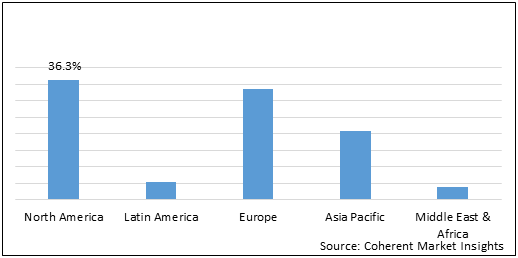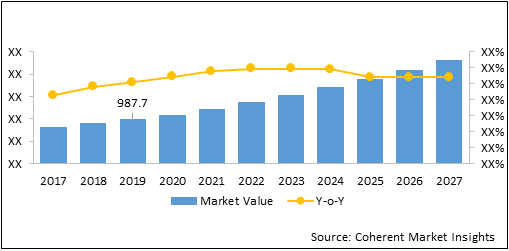Market Overview
Sustainability and energy management software a system database of information associated with financial data, energy, resources, and other important factors. These factors aid enterprises to monitor, analyze, and control operations. This software is designed to help enterprises enhance energy and sustainability business performance through automated data analysis, management, and reporting. Currently, enterprises are necessitated to monitor and analyze their performance in numerous ways. Sustainability & energy management software support increased use of software in operations, compliance with regulatory obligations, streamlining of processes, effective understanding of risks, overlapping reporting requirements, etc.
The global sustainability & energy management software market is estimated to account for US$ 2,326.2 Mn in terms of value by the end of 2027.
Market Dynamics- Drivers
Major organizations in various sectors such as oil & gas exploration and production are focused on strategizing, in order to create value through sustainability. These organizations seek to improve returns on capital day by reducing operating costs via improved natural-resource management, in order to achieve this goal. Moreover, key organizations in the market are regularly revising their business portfolios, in order to determine the potential impact of trends to leverage new growth opportunities. For instance, in March 2016, ArcelorMittal, a multinational steel manufacturing corporation, incorporated sustainability in its organizational design through a department for scientific analyses of the life cycles of steel products.
Major resource-focused industries use a large amount of water, raw materials, energy, and water resources. This, in turn, leads to a large number of emissions, solid waste, and effluents. Generally, these industries are subjected to various regulatory policies and norms. Furthermore, enterprises are focused on adopting sustainability management solutions in order to comply with strict regulatory policies. Therefore, these factors are expected to propel the global sustainability & energy management software market growth in the near future.
Statistics:
North America held dominant position in the global sustainability & energy management software market in 2019, accounting for 36.3% share in terms of value, followed by Europe, APAC, Latin America, and MEA respectively.
Figure 1: Global Sustainability & Energy Management Software Market Share (%), in terms of Value, By Region, 2019

To learn more about this report, Download Free Sample
Market Dynamics- Restraints
There is a lack of reliable data, standards, and common practices within and across companies, which results in missed opportunities. Only major enterprises are practicing green initiatives such as lighting replacements, enhanced procurement strategies, and taking advantage of tax benefits for renewable energy generation. However, SMEs from emerging economies are yet to implement green initiatives, which in turn, is expected to restrain growth of the global sustainability & energy management software market during the forecast period.
Stringent government measures regarding environment protection often impose market access restrictions on for enterprises, which in turn affect competitiveness. The effect of such measures is comparatively more pronounced in emerging economies mainly due to lack of infrastructure and monitoring facilities, limited technology choices, inadequate access to environment-friendly raw materials, lack of reliable data, and large number of small-scale exporters. For instance, in developed economies such as the U.S., Canada, and countries in Europe, SMEs in the leather sector have vanished due to strict environmental legislation. However, in emerging economies, majority of the tanning industry comprises SMEs processing raw to semi-finished leather.
| Report Coverage | Details | ||
|---|---|---|---|
| Base Year: | 2019 | Market Size in 2019: | US$ 987.7 Mn |
| Historical Data for: | 2016 to 2019 | Forecast Period: | 2020 to 2027 |
| Forecast Period 2020 to 2027 CAGR: | 11.4% | 2027 Value Projection: | US$ 2,326.2 Mn |
| Geographies covered: |
|
||
| Segments covered: |
|
||
| Companies covered (15): |
IBM Corp. (TRIRIGA), Figbytes Inc., Schneider Electric, Gensuite LLC, SAP SE, Envizi, ICONICS, Inc., Ecova, Inc. Urjanet, Verisae, Inc., Thinkstep, UL EHS Sustainability, Enablon, Sphera, CA Technologies, and Accuvio. |
||
| Growth Drivers: |
|
||
| Restraints & Challenges: |
|
||
Uncover macros and micros vetted on 75+ parameters: Get instant access to report
Market Opportunities
Many sectors have started adopting cloud computing for various applications. However, its benefits still remain undervalued in the sustainability and energy management space. Cloud-based technology provides various benefits of updating and upgrading software in real-time, thereby allowing users to utilize data more efficiently. It can be adopted in enterprises to gain significant benefits such as robustness, scalability, reduced complexity, low cost, and granular level of visibility of sustainable information. Moreover, these solutions can help companies improve their performance, achieve greater return on investment, and generate more efficient reports.
SMEs are demanding software solutions that are sophisticated, convenient, and provide value-for-money. Thus, delivering different choices in options can create immense potential revenue opportunities for sustainability & energy management software vendors. Providing an end-to-end customer experience that complies with industry standards can offer major business opportunities for market players in the near future.
Figure 2: Global Sustainability & Energy Management Software Market Value (US$ Mn), 2017 - 2027

To learn more about this report, Download Free Sample
The global sustainability & energy management software market was valued at US$ 987.7 Mn in 2019 and is forecast to reach a value of US$ 2,326.2 Mn by 2027 at a CAGR of 11.4% between 2020 and 2027.
Market Trends
Key players operating in the market are focused on partnerships and collaborations, in order to expand portfolio and gain a competitive edge in the market. For instance, in October 2016, Schneider Electric partnered with Panasonic Corporation, which is a developer electronics technologies and solutions, in order to simplify energy management with innovative integration and optimize building efficiency and installation costs. In February 2016, IBM Corporation partnered with Siemens Building Technologies Division and launched cloud-based building management platform leveraging enterprise asset management and data analytics technologies.
Major market players are involved in merger and acquisition activities, in order to enhance the market presence and gain a significant advantage. For instance, in 2016, Accruent acquired Verisae Inc., in order to improve its market reach and industry visibility. Furthermore, in 2016, Accruent acquired BigCenter (Business Integration Group, Inc.).
Value Chain Analysis
Software industry value chain consists of a complex structure which includes several stages, with each stage further disaggregated in multiple activities. Interactions and linkages established between each phase and among different stages are the main determinant of the industry effectiveness and success.
Competitive Section
Key players operating in the global sustainability & energy management software market are IBM Corp. (TRIRIGA), Figbytes Inc., Schneider Electric, Gensuite LLC, SAP SE, Envizi, ICONICS, Inc., Ecova, Inc. Urjanet, Verisae, Inc., Thinkstep, UL EHS Sustainability, Enablon, Sphera, CA Technologies, and Accuvio.
Key Development
Share
Share
Missing comfort of reading report in your local language? Find your preferred language :
Transform your Strategy with Exclusive Trending Reports :
Frequently Asked Questions
Select a License Type
Joining thousands of companies around the world committed to making the Excellent Business Solutions.
View All Our Clients